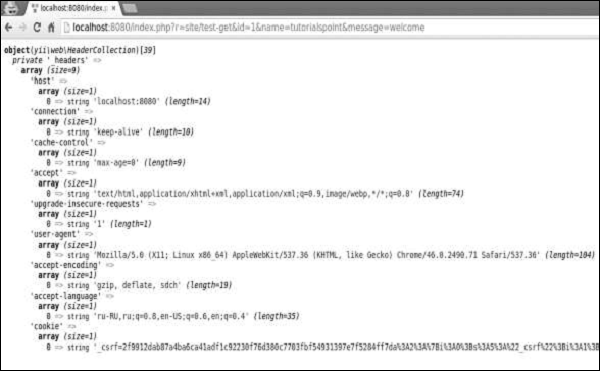
- Yii 教程
- Yii - 主页
- Yii - 概述
- Yii - 安装
- Yii - 创建页面
- Yii - 应用程序结构
- Yii - 入口脚本
- Yii - 控制器
- Yii - 使用控制器
- Yii - 使用动作
- Yii - 模型
- Yii - 小部件
- Yii - 模块
- Yii - 视图
- Yii - 布局
- Yii - 资产
- Yii - 资产转换
- Yii - 扩展
- Yii - 创建扩展
- Yii - HTTP 请求
- Yii - 响应
- Yii - URL 格式
- Yii - URL 路由
- Yii - URL 规则
- Yii - HTML 表单
- Yii - 验证
- Yii - 临时验证
- Yii - AJAX 验证
- Yii - 会话
- Yii - 使用闪存数据
- Yii - cookie
- Yii - 使用 Cookie
- Yii - 文件上传
- Yii - 格式化
- Yii - 分页
- Yii - 排序
- Yii - 属性
- Yii - 数据提供者
- Yii - 数据小部件
- Yii - 列表视图小部件
- Yii - GridView 小部件
- Yii - 活动
- Yii - 创建事件
- Yii - Behave
- Yii - 创建Behave
- Yii - 配置
- Yii - 依赖注入
- Yii - 数据库访问
- Yii - 数据访问对象
- Yii - 查询生成器
- Yii - 活动记录
- Yii - 数据库迁移
- Yii - 主题化
- Yii - RESTful API
- Yii - RESTful API 的实际应用
- Yii - 字段
- Yii - 测试
- Yii - 缓存
- Yii - 片段缓存
- Yii - 别名
- Yii - 日志记录
- Yii - 错误处理
- Yii - 身份验证
- Yii - 授权
- Yii - 本地化
- Yii-Gii
- Gii – 创建模型
- Gii – 生成控制器
- Gii – 生成模块
- Yii 有用的资源
- Yii - 快速指南
- Yii - 有用的资源
- Yii - 讨论
Yii - HTTP 请求
请求由yii\web\Request对象表示,它提供有关 HTTP 标头、请求参数、cookie 等的信息。
get()和post()方法返回请求组件的请求参数。
示例-
$req = Yii::$app->request;
/*
* $get = $_GET;
*/
$get = $req->get();
/*
* if(isset($_GET['id'])) {
* $id = $_GET['id'];
* } else {
* $id = null;
* }
*/
$id = $req->get('id');
/*
* if(isset($_GET['id'])) {
* $id = $_GET['id'];
* } else {
* $id = 1;
* }
*/
$id = $req->get('id', 1);
/*
* $post = $_POST;
*/
$post = $req->post();
/*
* if(isset($_POST['name'])) {
* $name = $_POST['name'];
* } else {
* $name = null;
* }
*/
$name = $req->post('name');
/*
* if(isset($_POST['name'])) {
* $name = $_POST['name'];
* } else {
* $name = '';
* }
*/
$name = $req->post('name', '');
步骤 1 - 将actionTestGet函数添加到基本应用程序模板的SiteController中。
public function actionTestGet() {
var_dump(Yii::$app->request->get());
}
步骤 2 - 现在转到http://localhost:8080/index.php?r=site/testget&id=1&name=tutorialspoint&message=welcome,您将看到以下内容。

要检索其他请求方法(PATCH、DELETE 等)的参数,请使用yii\web\Request::getBodyParam()方法。
要获取当前请求的 HTTP 方法,请使用Yii::$app→request→method属性。
步骤 3 - 修改actionTestGet函数,如以下代码所示。
public function actionTestGet() {
$req = Yii::$app->request;
if ($req->isAjax) {
echo "the request is AJAX";
}
if ($req->isGet) {
echo "the request is GET";
}
if ($req->isPost) {
echo "the request is POST";
}
if ($req->isPut) {
echo "the request is PUT";
}
}
步骤 4 - 转到http://localhost:8080/index.php?r=site/test-get。您将看到以下内容。

请求组件提供了许多属性来检查所请求的 URL。
步骤 5 - 修改actionTestGet函数如下。
public function actionTestGet() {
//the URL without the host
var_dump(Yii::$app->request->url);
//the whole URL including the host path
var_dump(Yii::$app->request->absoluteUrl);
//the host of the URL
var_dump(Yii::$app->request->hostInfo);
//the part after the entry script and before the question mark
var_dump(Yii::$app->request->pathInfo);
//the part after the question mark
var_dump(Yii::$app->request->queryString);
//the part after the host and before the entry script
var_dump(Yii::$app->request->baseUrl);
//the URL without path info and query string
var_dump(Yii::$app->request->scriptUrl);
//the host name in the URL
var_dump(Yii::$app->request->serverName);
//the port used by the web server
var_dump(Yii::$app->request->serverPort);
}
步骤 6 - 在网络浏览器的地址栏中输入http://localhost:8080/index.php?r=site/testget&id=1&name=tutorialspoint&message=welcome,您将看到以下内容。

步骤 7 - 要获取 HTTP 标头信息,您可以使用yii\web\Request::$headers属性。这样修改actionTestGet函数。
public function actionTestGet() {
var_dump(Yii::$app->request->headers);
}
步骤 8 - 如果您访问 URL http://localhost:8080/index.php?r=site/testget&id=1&name=tutorialspoint&message=welcome,您将看到如下代码所示的输出。

要获取客户端计算机的主机名和 IP 地址,请使用userHost和userIP属性。
步骤 9 -以这种方式修改actionTestGet函数。
public function actionTestGet() {
var_dump(Yii::$app->request->userHost);
var_dump(Yii::$app->request->userIP);
}
步骤 10 - 转到地址http://localhost:8080/index.php?r=site/test-get,您会看到以下屏幕。
